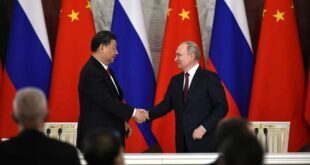China is conducting an unprecedented campaign below the threshold of armed conflict to expand the influence of the Chinese Communist Party and weaken the United States and its partners. This campaign involves sophisticated Chinese espionage activities, offensive cyber operations, disinformation on social media platforms, economic coercion, and influence operations targeting companies, universities, and other organizations. The scale of China’s actions in the United States is unparalleled. This report offers one of the most comprehensive analyses to date of Chinese political warfare activities and examines China’s main actions, primary goals, and options for the United States and its partners
Competing without Fighting: China’s Strategy of Political Warfare is a new report by the CSIS Transnational Threats Project focusing on Chinese influence strategies below the threshold of conventional armed conflict. Seth Jones, director of the CSIS International Security Program, sat down to discuss the report, including the importance of examining these tactics and how policymakers can counter them.
This interview, conducted by Lauren Adler, has been edited for brevity and clarity.
LA: This report provides one of the most comprehensive analyses to date on this issue. Why is this so important, and more specifically, why is it so important right now?
SGJ: There is almost every day a front-page story about Chinese activity in and around the U.S. homeland. But most of these stories are very compartmentalized and focus on only a piece of the broader issue. Some of these stories are about cyber, some of them are about espionage, and some are about Chinese police stations in cities like New York. We felt it was important to pull all of those different threads together into one study, and to examine the breadth of Chinese action.
It is important to do this now because in our interviews with the Federal Bureau of Investigation (FBI), they said from a counterintelligence perspective, this is the most aggressive period they have ever seen of Chinese activity. One official said to us, “The system is blinking red right now.”
LA: What is political warfare, and how is China using it?
SGJ: The term “political warfare” comes from the former U.S. State Department diplomat and Cold War historian George Kennan, and it refers to activities below the threshold of armed conflict. Political warfare includes cyber operations. It includes information and disinformation campaigns. It includes united front work, which involves efforts to expand influence in academic institutions and other locations. It also includes economic coercion, intelligence operations, and other activities. And these activities are largely designed to expand Chinese power, weaken the United States as part of balance of power competition, and, perhaps most importantly, preserve the rule of the Chinese Communist Party (CCP).
LA: In the report, you note that the U.S. homeland is the primary target of China’s political warfare. What tactics is China likely to use against the U.S. homeland specifically?
SGJ: The interesting thing about Chinese tactics is they are so widespread. We identified nearly a dozen separate Chinese agencies, in addition to non-state actors—hacktivist organizations, for example—involved in conducting cyberattacks, human intelligence collection, influence, and disinformation and misinformation on social media platforms. There is influence on universities and within companies; we have seen, for example, extensive efforts to control the messages coming out of companies like the National Basketball Association, or what movie studios are producing in Hollywood.
LA: How has the United States failed to counter those tactics?
SGJ: There are a couple of things. First, there is not really a systematic U.S. interagency process or organization for countering these activities. The U.S. response spans multiple different U.S. organizations and is not well coordinated. Second, the United States is under resourced. Organizations that we spoke to that are dealing with much of this, such as the FBI, are entirely swamped right now. They do not have enough agents or intelligence analysts to deal with a growing Chinese counterintelligence campaign—in addition to Russian, Iranian, and other counterintelligence activity in the United States. So those are the kinds of things that we identified as critical. Third, there is also substantial influence—some of it illegal influence—involving foreign agents with links to China. There are significant attempts by individuals associated with China to influence what is going on either on Capitol Hill or in research institutions. That concern is pretty extensive across the United States.
LA: How should policymakers be thinking about this issue to effectively counter those tactics?
SGJ: At the federal level, we looked at the need for increasing counterintelligence resources among federal agencies, primarily the Department of Justice, including the FBI, and the Department of Homeland Security. But it is not just the federal government. We also looked at expanding state and local counterintelligence resources. There are a number of states, such as New Jersey, that are making an extraordinary effort to build counterintelligence capabilities against China. But these efforts need to be more widespread across U.S. states.
In addition, the United States needs to strengthen its Foreign Agent Registration Act, or FARA, and related efforts, including the Lobbying Disclosure Act and the Department of Education’s section 117 disclosures. These efforts are really to counter Chinese and other foreign influence. We have some suggestions about providing additional civil investigative demand authority to the Department of Justice as it looks at these issues, increasing the penalties for noncompliance with FARA, as well as repealing or modifying exemptions for FARA.
Those are mostly defensive measures. In addition, we outlined a series of offensive measures. One is, much like the United States did to the Soviet Union during the Cold War, looking at ways to weaken China’s Great Firewall, which attempts to control China’s message inside and outside the country in ways that benefit the CCP. The United States was quite effective during the Cold War with Radio Free Europe/Radio Liberty of getting information into those locations. There are similar efforts that could be done today inside and outside of China. In addition, the United States needs to deepen its partnerships with Australia, South Korea, Japan, and other partners, including in areas like pushing back against Chinese economic coercion. And finally, one last area on offense is increasing U.S. private sector competitiveness in emerging technology in the Global South, where the Chinese are making a very specific, aggressive effort in what they call the Digital Silk Road. This would be a much more significant public-private partnership with such companies as Google, Amazon, Apple, Microsoft, and others so that they can compete more effectively with Chinese companies.
Seth G. Jones is senior vice president, Harold Brown Chair, and director of the International Security Program at the Center for Strategic and International Studies (CSIS) in Washington, D.C. Lauren Adler is content coordinator with CSIS External Relations.
 Geostrategic Media Political Commentary, Analysis, Security, Defense
Geostrategic Media Political Commentary, Analysis, Security, Defense





